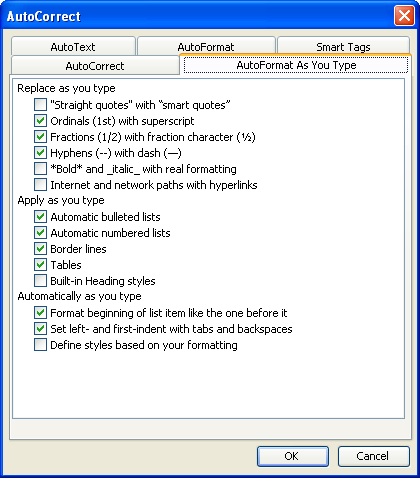Please Note: This article is written for users of the following Microsoft Word versions: 97, 2000, 2002, and 2003. If you are using a later version (Word 2007 or later), this tip may not work for you. For a version of this tip written specifically for later versions of Word, click here: Problem Printing Quotation Marks.
Written by Allen Wyatt (last updated October 6, 2020)
This tip applies to Word 97, 2000, 2002, and 2003
Sharon reported a problem she was having with quotation marks in some of her documents. It seems that she would type the quotation marks around a word or phrase, and they would look fine on the screen. Then, when she printed the document, the quotation marks would not print properly—they would often look like a thick, dark # sign.
When you enter quotation marks in a document, they can be any of three different characters. The regular quotation mark has a character code of 34. However, if you have the Smart Quotes feature of Word turned on, the quotation marks could use character codes of 147 and 148, depending on whether it is an opening or closing quotation mark.
If your quotation marks are not printing properly, it is typically because the font being used does not have symbols associated with character codes 147 and 148. For instance, the Courier font does not have characters for these codes. When displaying the document on the screen, Word substitutes a screen font that displays the opening and closing quotation marks properly, but then when the document is printed, the printer font (Courier) does not have them, so it either skips them or substitutes a different symbol for the characters.
There are two potential solutions to this problem. The first is to simply change to a different font for your document. For instance, if your document uses Courier, you could switch to Courier New, which does have the proper quotation mark characters.
The second solution (which should be used if you don't want to change the font) is to turn off Smart Quotes and change all existing instances of opening and closing quotes to regular quotes. Turn off Smart Quotes in this manner:

Figure 1. The AutoFormat As You Type tab of the AutoCorrect dialog box.
If the problem continues to exist, you may have a problem with your printer driver. In this case, you should visit the printer manufacturer's Web site and download the latest version of their printer driver.
WordTips is your source for cost-effective Microsoft Word training. (Microsoft Word is the most popular word processing software in the world.) This tip (35) applies to Microsoft Word 97, 2000, 2002, and 2003. You can find a version of this tip for the ribbon interface of Word (Word 2007 and later) here: Problem Printing Quotation Marks.

Learning Made Easy! Quickly teach yourself how to format, publish, and share your content using Word 2013. With Step by Step, you set the pace, building and practicing the skills you need, just when you need them! Check out Microsoft Word 2013 Step by Step today!
Have you noticed page layout differences when you open a document on different systems? There are a number of reasons why ...
Discover MoreNeed to stop the printing of a long document? Here's how to stop Word, along with why stopping Word may not be the only ...
Discover MoreOne of the lesser-known features of Word is that it allows you to create a document for one page size and scale the ...
Discover MoreFREE SERVICE: Get tips like this every week in WordTips, a free productivity newsletter. Enter your address and click "Subscribe."
There are currently no comments for this tip. (Be the first to leave your comment—just use the simple form above!)
Got a version of Word that uses the menu interface (Word 97, Word 2000, Word 2002, or Word 2003)? This site is for you! If you use a later version of Word, visit our WordTips site focusing on the ribbon interface.
Visit the WordTips channel on YouTube
FREE SERVICE: Get tips like this every week in WordTips, a free productivity newsletter. Enter your address and click "Subscribe."
Copyright © 2024 Sharon Parq Associates, Inc.
Comments